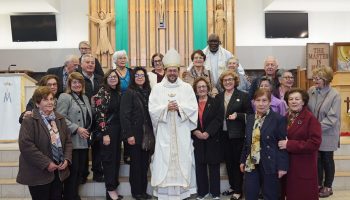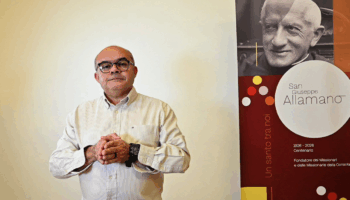
On the occasion of the centenary of the presence of the Consolata missionary Sisters in Ethiopia (1924-2024), we offer some incites to understand the historical context that the missionaries encountered at the beginning of their discreet and respectful presence in this great country of East Africa.
By Ashenafi Yonas Abebe *
The mission is a gift that pushes us to give ourselves to others. The missionary heart yearns for the mission and never rests until it has achieved its purpose.
Even though Blessed Joseph Allamano had never been to Ethiopia, in his mind and heart he had a strong desire to go there to get to know that people and continue the work of evangelization begun by the great missionary bishop, the Capuchin Guglielmo Massaia, who Allamano had the opportunity to meet and listen. He was so impressed by that encounter, that it became an indelible memory to which he continually returned to renew his zeal and passion for those lands visited by the great missionary bishop.
A fire had been lit never to go out again, the fire of the mission. Guided by the Holy Spirit and Our Lady Consolata, supported by Cardinal Richelmy and his friend and collaborator James Camissasa, in 1901 Allamano founded the Consolata Missionary Institute and in 1910 the Consolata Missionary Sisters who could reach the long-awaited land of Ethiopia.

The first missionaries failed to reach that goal and were forced, at the start, to retreat to Kenya in the hope that more favorable circumstances could lead to the crossing of the border. From Kenya, Monsignor Perlo, in charge of carrying out the opening plan of the new mission, lent a hand to Monsignor Gaudenzio Barlassina to look for ways to enter Kaffa in Ethiopia.
Just after a few years of patience and repeated attempts, in 1914 a small group led by Father Angelo Dal Canton left for Ethiopia but had to remain for several months in Moyale, on the border between Kenya and Ethiopia, waiting to obtain the documents necessary to enter. In the meantime, James Camisassa, for his part, was in close contact with the Italian authorities in Addis Ababa, in fact at the time the missions were considered not only religious and civilization activity, but also outposts of “Italianness”.
Eventually, Father Dal Canton obtained a permit to reside in Burgi, on the border with the Kaffa region in the southern part of Ethiopia, but on the following year he was forced to leave the country due to various religious and political factors.
In the meantime, the missionaries in Kenya continued to look for new ways to reach the desired goal, and the Allamano too supported and accompanied their efforts. He was so confident that that “dream” would become true that he had Monsignor Gaudenzio Barlassina leave for Kenya, where he arrived in February 1915, with the intention of reaching Kaffa, once the bureaucratic obstacles would be over.
Mons. Gaudenzio Barlassina was a courageous and determined missionary, creative and visionary to the point that he devised a new strategy to enter Ethiopia. First of all he followed another itinerary: from Mombasa he passed through Mogadisco, Aden, Djibouti, and he finally reached Addis Ababa on Christmas eve 1916. The local authorities, intrigued by his presence, secretly investigated who this “strange character” was: a disguised soldier, a German spy, a commercial agent, a journalist?
Monsignor Barlassina met Prince Tefarì Mekonnen (the future emperor Haile Selassie I) and presented humanitarian motivations as the reason for his entry into Ethiopia: the intellectual and moral formation of the Ethiopian people through agriculture and trade. After having obtained a written commercial license from the local chief for himself and his two companions, Gaudenzio Barlassina clandestinely began his missionary activity in the then Apostolic Prefecture of Kaffa.

The arrival of the Consolata Missionary Sisters
In 1924 the Consolata Missionary Sisters arrived in Ethiopia, who this year are celebrating the centenary of their evangelizing presence and mission of consolation in Ethiopia, bringing to fulfilment the dream of our Founder Blessed Joseph Allamano.
The missionaries in their modest beginning were aware that, unlike other situations in Africa, a good dose of humility, respect and listening was required so as not to irritate the priests of the local Church or awaken the animosity of the local leaders, in a nation that had an Orthodox Church with a thousand-year-old apostolic tradition, with its own sacred books, ancient manuscripts, temples, theology, literature and its own liturgical rite.
Little by little, as the years passed, the Founder’s dream took shape in the creation of various mission stations: Ghimbi, Billo, Anderacha, Umbi, Magi, Komto, Melka Oda, Guder, Cianna, Gimma, Bonga, etc.
Due to the outbreak of the Second World War and the resulting Italian-Ethiopian conflict, these missions remained abandoned for about thirty years, as all the missionaries were expelled from the country. Father Gaudenzio Barlassina had founded the local congregation of the Handmaid Sisters of Maria Consolata who continued a presence that lasted until the return of the Consolata Missionary Sisters on 22 August 1974. Some missionaries returned as chaplains and interpreters of the invading Italian army. Whether this was a wise move by Monsignor Gaudenzio Barlassina, is still debatable!
After the tragedy of the war, the dawn of a new, albeit slow beginning awaited. Expelled during the war, the Consolata Missionary Institute had to struggle to return. Father Giovanni de Marchi, an Italian missionary, holding an American passport, who in the 60s was working in Nyeri, Kenya; like a worthy son of Joseph Allamano, dreamed of bringing the Institute back to Ethiopia. This happened starting in 1970, thanks to his commitment and the meeting Father Mario Bianchi, who was Superior General, had with the Emperor Hailè Selassie, who was visiting Turin.

The protagonists of this miraculous “dawn of a new day”, were the first seven missionaries, who entered the country as ” development and cooperation promotors”: Giovanni De Marchi, Lorenzo Cavallera, Lorenzo Pietro Ori, Silvio Sordella, Antonio Vismara, Domenico Zordan and Tarcisio Rossi. In 1974 the Consolata missionary Sisters joined them to resume their service in the pastoral care of the sick, women and youth.
Currently the Consolata Missionaries are present in the archdiocese of Addis Ababa (Addis Ababa, Modjo), and in the Apostolic Vicariate of Meki (Weragu, Gambo and Halaba). Thanks to God, the flourishing of local missionary vocations continues: there are around 20 Ethiopian Consolata missionaries working in three continents and there is a good number of seminarians in formation houses. Likewise, we have several Ethiopian Consolata Missionary Sisters who work in different parts of the world.
After sunset always comes a new dawn! After the storm, the sun reappears! Best wishes!
* Father Ashenafi Yonas Abebe, IMC, studies Church history in Rome.



